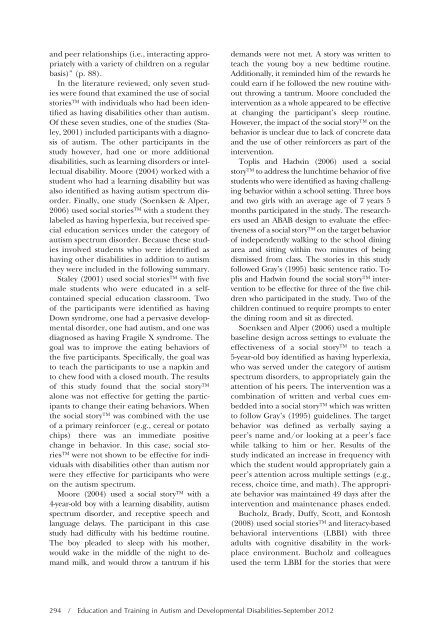etadd_47(3) - Division on Autism and Developmental Disabilities
etadd_47(3) - Division on Autism and Developmental Disabilities
etadd_47(3) - Division on Autism and Developmental Disabilities
Create successful ePaper yourself
Turn your PDF publications into a flip-book with our unique Google optimized e-Paper software.
<strong>and</strong> peer relati<strong>on</strong>ships (i.e., interacting appropriately<br />
with a variety of children <strong>on</strong> a regular<br />
basis)” (p. 88).<br />
In the literature reviewed, <strong>on</strong>ly seven studies<br />
were found that examined the use of social<br />
stories with individuals who had been identified<br />
as having disabilities other than autism.<br />
Of these seven studies, <strong>on</strong>e of the studies (Staley,<br />
2001) included participants with a diagnosis<br />
of autism. The other participants in the<br />
study however, had <strong>on</strong>e or more additi<strong>on</strong>al<br />
disabilities, such as learning disorders or intellectual<br />
disability. Moore (2004) worked with a<br />
student who had a learning disability but was<br />
also identified as having autism spectrum disorder.<br />
Finally, <strong>on</strong>e study (Soenksen & Alper,<br />
2006) used social stories with a student they<br />
labeled as having hyperlexia, but received special<br />
educati<strong>on</strong> services under the category of<br />
autism spectrum disorder. Because these studies<br />
involved students who were identified as<br />
having other disabilities in additi<strong>on</strong> to autism<br />
they were included in the following summary.<br />
Staley (2001) used social stories with five<br />
male students who were educated in a selfc<strong>on</strong>tained<br />
special educati<strong>on</strong> classroom. Two<br />
of the participants were identified as having<br />
Down syndrome, <strong>on</strong>e had a pervasive developmental<br />
disorder, <strong>on</strong>e had autism, <strong>and</strong> <strong>on</strong>e was<br />
diagnosed as having Fragile X syndrome. The<br />
goal was to improve the eating behaviors of<br />
the five participants. Specifically, the goal was<br />
to teach the participants to use a napkin <strong>and</strong><br />
to chew food with a closed mouth. The results<br />
of this study found that the social story<br />
al<strong>on</strong>e was not effective for getting the participants<br />
to change their eating behaviors. When<br />
the social story was combined with the use<br />
of a primary reinforcer (e.g., cereal or potato<br />
chips) there was an immediate positive<br />
change in behavior. In this case, social stories<br />
were not shown to be effective for individuals<br />
with disabilities other than autism nor<br />
were they effective for participants who were<br />
<strong>on</strong> the autism spectrum.<br />
Moore (2004) used a social story with a<br />
4-year-old boy with a learning disability, autism<br />
spectrum disorder, <strong>and</strong> receptive speech <strong>and</strong><br />
language delays. The participant in this case<br />
study had difficulty with his bedtime routine.<br />
The boy pleaded to sleep with his mother,<br />
would wake in the middle of the night to dem<strong>and</strong><br />
milk, <strong>and</strong> would throw a tantrum if his<br />
dem<strong>and</strong>s were not met. A story was written to<br />
teach the young boy a new bedtime routine.<br />
Additi<strong>on</strong>ally, it reminded him of the rewards he<br />
could earn if he followed the new routine without<br />
throwing a tantrum. Moore c<strong>on</strong>cluded the<br />
interventi<strong>on</strong> as a whole appeared to be effective<br />
at changing the participant’s sleep routine.<br />
However, the impact of the social story <strong>on</strong> the<br />
behavior is unclear due to lack of c<strong>on</strong>crete data<br />
<strong>and</strong> the use of other reinforcers as part of the<br />
interventi<strong>on</strong>.<br />
Toplis <strong>and</strong> Hadwin (2006) used a social<br />
story to address the lunchtime behavior of five<br />
students who were identified as having challenging<br />
behavior within a school setting. Three boys<br />
<strong>and</strong> two girls with an average age of 7 years 5<br />
m<strong>on</strong>ths participated in the study. The researchers<br />
used an ABAB design to evaluate the effectiveness<br />
of a social story <strong>on</strong> the target behavior<br />
of independently walking to the school dining<br />
area <strong>and</strong> sitting within two minutes of being<br />
dismissed from class. The stories in this study<br />
followed Gray’s (1995) basic sentence ratio. Toplis<br />
<strong>and</strong> Hadwin found the social story interventi<strong>on</strong><br />
to be effective for three of the five children<br />
who participated in the study. Two of the<br />
children c<strong>on</strong>tinued to require prompts to enter<br />
the dining room <strong>and</strong> sit as directed.<br />
Soenksen <strong>and</strong> Alper (2006) used a multiple<br />
baseline design across settings to evaluate the<br />
effectiveness of a social story to teach a<br />
5-year-old boy identified as having hyperlexia,<br />
who was served under the category of autism<br />
spectrum disorders, to appropriately gain the<br />
attenti<strong>on</strong> of his peers. The interventi<strong>on</strong> was a<br />
combinati<strong>on</strong> of written <strong>and</strong> verbal cues embedded<br />
into a social story which was written<br />
to follow Gray’s (1995) guidelines. The target<br />
behavior was defined as verbally saying a<br />
peer’s name <strong>and</strong>/or looking at a peer’s face<br />
while talking to him or her. Results of the<br />
study indicated an increase in frequency with<br />
which the student would appropriately gain a<br />
peer’s attenti<strong>on</strong> across multiple settings (e.g.,<br />
recess, choice time, <strong>and</strong> math). The appropriate<br />
behavior was maintained 49 days after the<br />
interventi<strong>on</strong> <strong>and</strong> maintenance phases ended.<br />
Bucholz, Brady, Duffy, Scott, <strong>and</strong> K<strong>on</strong>tosh<br />
(2008) used social stories <strong>and</strong> literacy-based<br />
behavioral interventi<strong>on</strong>s (LBBI) with three<br />
adults with cognitive disability in the workplace<br />
envir<strong>on</strong>ment. Bucholz <strong>and</strong> colleagues<br />
used the term LBBI for the stories that were<br />
294 / Educati<strong>on</strong> <strong>and</strong> Training in <strong>Autism</strong> <strong>and</strong> <strong>Developmental</strong> <strong>Disabilities</strong>-September 2012

















